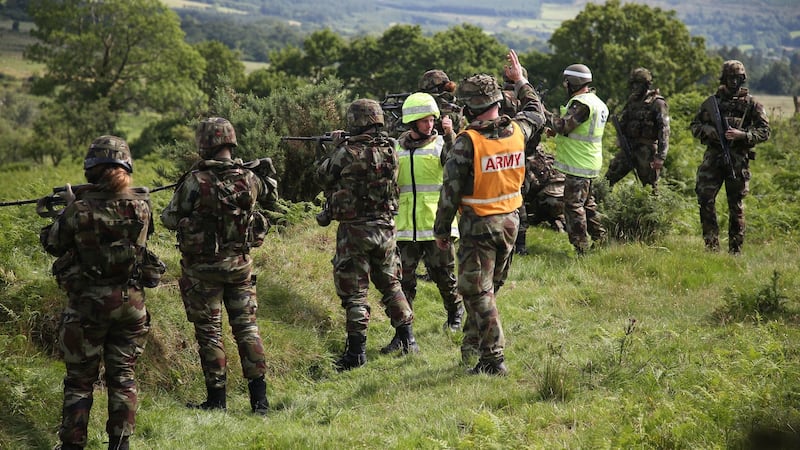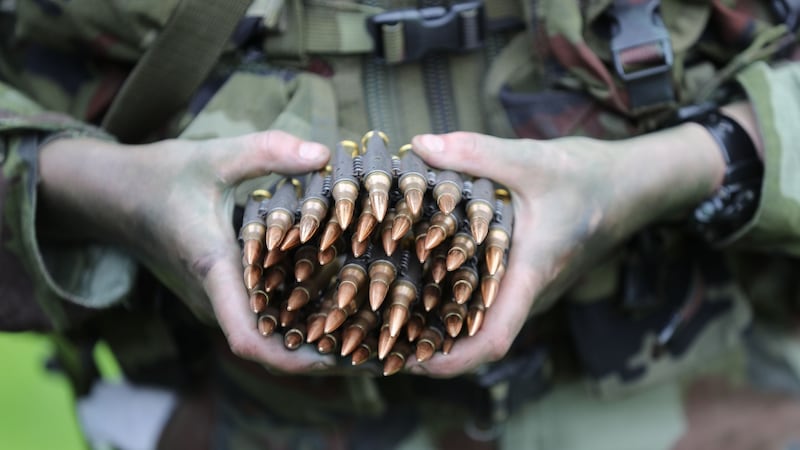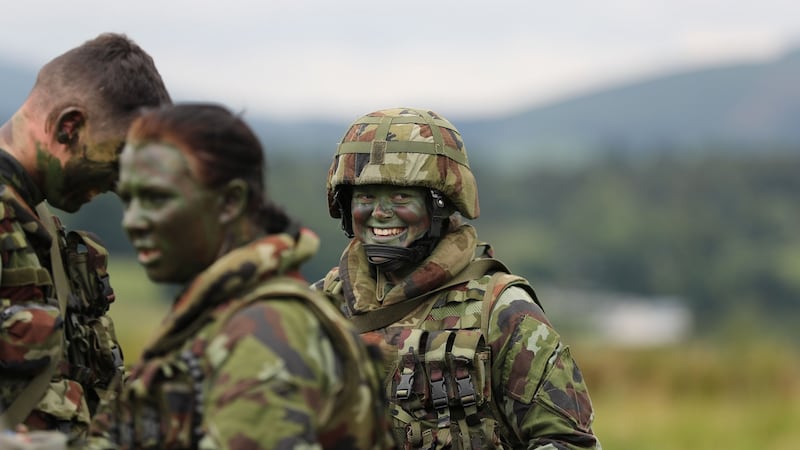Surveying the troops of 157th recruit platoon from a ridge on "Cemetery Hill", in the Glen of Imaal, Comdt Padraig Duggan can spot a lot of mistakes.
Some new soldiers fumble slightly with the magazine of their Steyr rifle as they manoeuvre through the scrub and fire at targets which are raised and lowered via ropes. Others run a little bit far from their buddy as they make their way to the safety of the ridge line in the shadow of Lugnaquilla.
The errors are not visible to the untrained eye but Duggan, a 19-year veteran of the Defence Forces, spots them instantly. He is not concerned; today is about building confidence, not perfection.
“We’re trying to get rid of the nervous energy they might have. This is about getting them used to firing live rounds, communicating and moving. We work out the kinks later.”
The recruits of the 157th platoon were excited and a little tense as they donned camouflage paint in preparation for the Live Fire Tactical Training (LFTT) exercise last Thursday. The coronavirus pandemic meant this was their first major training exercise in months and they were eager to get back into it.
“It’s a significant day, it’s their first time firing live rounds while moving. Everything, from the first day they pick up the rifle, builds up to today,” says platoon commander Lieut Austin “Ossie” Doyle.

The day starts with buddy manoeuvres. The recruits move in pairs until someone shouts “contact” and the targets pop up. They must then cover each other with rifle fire while withdrawing to safety.
The exercises build to a nine-person assault of a fixed position using grenades and heavy machine guns.
One might wonder why Irish soldiers, whose chief overseas purpose will be peacekeeping missions, need to practice such aggressive manoeuvres.
Not ‘NGOs in uniform’
It is a question which some find slightly frustrating. “Some people think we’re just NGOs in uniform,” says one. “That’s not our role.”
Exercises such as today’s are the “building blocks” of an army, says Duggan, and they see real-world use more often than people might think. Take for example a 2014 operation by Irish troops to rescue dozens of captured Filipino peacekeepers in the Golan Heights which saw Irish troops engage in a gun battle with Islamic militants.
“On occasion there are major incidents and you have to be trained to deal with those,” says Duggan. “It has to be muscle memory. The recruits will do this over and over again each year so it becomes second nature.”
Those types of missions are what attract people like Pte Adam O’Rourke (20) to the Defence Forces. “I didn’t join the Army for the pay. I joined for the excitement and an adventurous career,” he says.
For others, like Pte Nicole Carroll, joining was almost preordained. She grew up beside the Curragh Camp and most of her family joined the Defence Forces. One of six women in the platoon, she says the best thing about the Army is the "unreal bond" between recruits. "It's a whole different sense of friendship. You'd die for them."

Popular military-themed video games give some new recruits unrealistic expectations of military life. “People have an interest in it, a lot more so than there was 15 years ago,” says Duggan.
Is that a good or bad thing? He pauses before answering: “It’s more about harnessing it appropriately. It’s a very different reality to video games. The first thing you’re teaching them is how to march. Maybe the expectation is you’re handing them a weapon and it’s Call of Duty straight away. But the reality is very different.”
Assault begins
After lunch it is time for the section attack and the first job is to prime the grenades. For obvious reasons this is done by one soldier some distance away from the rest of the group. As the private screws in the fuse, Duggan tells us the grenade has a nine-metre “kill radius” and a four-second fuse. The Irish Times takes a few more steps back.
Once the assault begins, it appears at first glance that the troops are moving randomly down the Glen. But it is all carefully choreographed, says Corporal Brian Kiernan. "We go through the theory of everything with them first."
Exercises like this take weeks of preparation. As well as the extensive paper work and permissions involved, individual rocks have to be removed to minimise the danger of ricochets, and flags have to be placed around the Glen to ward off hillwalkers. (Even with these precautions it is not unknown for the odd hiker to stumble across proceedings.)

As we walk through the firefight, Duggan explains the challenge of achieving a “balance between safety and realism” in training.
“I know it seems mental for her to be firing a rifle there and us to be walking here”, he says “but everyone is aware of the arcs of fire at all times”.
After crawling through the underbrush, a soldier reaches the objective and throws a grenade before standing up and spraying the area with automatic fire. A surprise target appears further down the field which is hit by a volley of fire from the recruits. “We like to keep them guessing,” says Duggan.
With the day’s training done, it is back to base. At one time the soldiers would have stopped in Fenton’s Pub down the road for refreshments but those days are long gone. “No one drinks in the Army anymore,” says an older soldier, a note of disappointment in his voice.


















